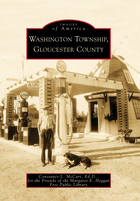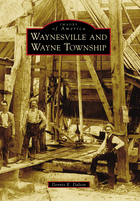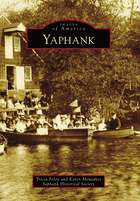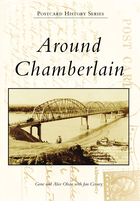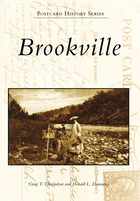Browse Titles - 76 results
6. Mills, Factories, and Businesses
written by Constance L. McCart; in Washington Township, Gloucester County, Images of America (Charleston, SC: Arcadia Publishing, 2009), 77-96
Washington Township, now the largest community in Gloucester County, was first incorporated in 1836. Its 22 acres of land, however, had been settled by Europeans as early as the 18th century, when farms were established near Lenni-Lenape encampments. By the mid-19th century, the area listed the communities of Hurf...
Sample
written by Constance L. McCart; in Washington Township, Gloucester County, Images of America (Charleston, SC: Arcadia Publishing, 2009), 77-96
Description
Washington Township, now the largest community in Gloucester County, was first incorporated in 1836. Its 22 acres of land, however, had been settled by Europeans as early as the 18th century, when farms were established near Lenni-Lenape encampments. By the mid-19th century, the area listed the communities of Hurffville, Turnersville, Spring Mills or Grenloch Terrace, Dilkesboro, Creesville, Bunker Hill, Chestnut Ridge, and Bells Lake within the...
Washington Township, now the largest community in Gloucester County, was first incorporated in 1836. Its 22 acres of land, however, had been settled by Europeans as early as the 18th century, when farms were established near Lenni-Lenape encampments. By the mid-19th century, the area listed the communities of Hurffville, Turnersville, Spring Mills or Grenloch Terrace, Dilkesboro, Creesville, Bunker Hill, Chestnut Ridge, and Bells Lake within the township borders. While it remained a farming community throughout the first half of the 20th century, during the 1950s modern housing developments began to replace the farms and peach orchards. The vintage photographs in Washington Township, Gloucester County have been compiled to serve as an archive and assist in preserving the township’s rich history.
Show more
Show less
Field of Study
American History
Content Type
Book
Author / Creator
Constance L. McCart
Date Published / Released
2009
Publisher
Arcadia Publishing
Series
Images of America
Topic / Theme
Grist mills, Textile mills, Factories, Lumber mills, Business, Industrial buildings, Buildings, Industry
Copyright Message
Copyright © 2009 by Constance L. McCart
×
2. Treasure in the River
written by Dennis E. Dalton; in Waynesville and Wayne Township, Images of America (Charleston, SC: Arcadia Publishing), 61-66
Samuel Heighway founded Waynesville in 1797 and thought his town would become the capital of the Northwest Territory—a dream that never materialized. However, Waynesville did grow up to become the “Antiques Capital of the Midwest,” snagging its own little piece of American heritage. Older than the state of O...
Sample
written by Dennis E. Dalton; in Waynesville and Wayne Township, Images of America (Charleston, SC: Arcadia Publishing), 61-66
Description
Samuel Heighway founded Waynesville in 1797 and thought his town would become the capital of the Northwest Territory—a dream that never materialized. However, Waynesville did grow up to become the “Antiques Capital of the Midwest,” snagging its own little piece of American heritage. Older than the state of Ohio, Waynesville has been home to its original settlers, the Quakers, and a long line of pioneers whose descendents still live in the a...
Samuel Heighway founded Waynesville in 1797 and thought his town would become the capital of the Northwest Territory—a dream that never materialized. However, Waynesville did grow up to become the “Antiques Capital of the Midwest,” snagging its own little piece of American heritage. Older than the state of Ohio, Waynesville has been home to its original settlers, the Quakers, and a long line of pioneers whose descendents still live in the area . . . even the ghosts have a hard time moving on! Waynesville successfully maintains its illusion of small-town America, to the delight of citizens and visitors alike.
Show more
Show less
Field of Study
American History
Content Type
Book
Author / Creator
Dennis E. Dalton
Publisher
Arcadia Publishing
Series
Images of America
Topic / Theme
Sport fishing, Fossils, Grist mills, Rivers
Copyright Message
Copyright © 2012 by Dennis E. Dalton
×
3. Fruits and Farms
written by Lynn M. Barton, Joan E. Sassone and Mary Hasek Grenier; in Webster, Images of America (Charleston, SC: Arcadia Publishing, 2010), 47-62
Sample
written by Lynn M. Barton, Joan E. Sassone and Mary Hasek Grenier; in Webster, Images of America (Charleston, SC: Arcadia Publishing, 2010), 47-62
Field of Study
American History
Content Type
Book
Author / Creator
Lynn M. Barton, Joan E. Sassone, Mary Hasek Grenier
Date Published / Released
2010
Publisher
Arcadia Publishing
Series
Images of America
Topic / Theme
Canneries, Family farms, Food industry, Farming, Fruits, Persons, Farms, Orchards and groves
Copyright Message
Copyright © 2010 by Lynn M. Barton, Joan E. Sassone, and Mary Hasek Grenier
×
1. Early Mill Days
Known for its sawmills and gristmills, Yaphank was established in 1726 on the banks of the Carmans River on Long Island. Called Millville until 1844, it was then named Yaphank, "bank of the river." Its two lakes mark the boundaries of the historic district, with Main Street winding between them. Though the mills a...
Sample
Description
Known for its sawmills and gristmills, Yaphank was established in 1726 on the banks of the Carmans River on Long Island. Called Millville until 1844, it was then named Yaphank, "bank of the river." Its two lakes mark the boundaries of the historic district, with Main Street winding between them. Though the mills are long gone, many of the period homes from the 18th and 19th centuries remain, illustrating the history of the village and those who l...
Known for its sawmills and gristmills, Yaphank was established in 1726 on the banks of the Carmans River on Long Island. Called Millville until 1844, it was then named Yaphank, "bank of the river." Its two lakes mark the boundaries of the historic district, with Main Street winding between them. Though the mills are long gone, many of the period homes from the 18th and 19th centuries remain, illustrating the history of the village and those who lived there. From the early days of the American Revolution, patriots marched on the Tallmadge Trail, and later, its young men went to fight for the Union cause in the Civil War. In 1871, Suffolk County's first almshouse was built to take care of the less fortunate. As World War I rumblings were heard, nearby Camp Upton— where Irving Berlin wrote the musical Yip, Yip, Yaphank—drew thousands of soldiers.
Show more
Show less
Field of Study
American History
Content Type
Book
Author / Creator
Tricia Foley
Publisher
Arcadia Publishing
Series
Images of America
Topic / Theme
Grist mills, Lumber mills, Mill towns, Town life, Industry
Copyright Message
Copyright © 2012 by Tricia Foley, Karen Mouzakes, and the Yaphank Historical Society
×
Making of America, Maritime Marion
in Making of America (Charleston, SC: Arcadia Publishing, 2002), 160 page(s),
Source: www.arcadiapublishing.com
Source: www.arcadiapublishing.com
Marion's relationship with the ocean has been the defining element in the small town's development since its settlement as Sippican in America's colonial era. Since 1678, generation after generation of Marion families have relied upon the opportunities a port and sea provide in both life and industry. The waters o...
Sample
in Making of America (Charleston, SC: Arcadia Publishing, 2002), 160 page(s),
Source: www.arcadiapublishing.com
Source: www.arcadiapublishing.com
Description
Marion's relationship with the ocean has been the defining element in the small town's development since its settlement as Sippican in America's colonial era. Since 1678, generation after generation of Marion families have relied upon the opportunities a port and sea provide in both life and industry. The waters of Buzzards Bay run deep in this coastal community, and its influence leaves an indelible mark not only upon every cove, beach, and inle...
Marion's relationship with the ocean has been the defining element in the small town's development since its settlement as Sippican in America's colonial era. Since 1678, generation after generation of Marion families have relied upon the opportunities a port and sea provide in both life and industry. The waters of Buzzards Bay run deep in this coastal community, and its influence leaves an indelible mark not only upon every cove, beach, and inlet, but upon the very spirit of each resident and visitor. For many, the sea is a temperamental and dangerous mistress, and Marion's affair with her is no different, for this town has experienced both great gain in wealth and horrific loss of life and property by her hands over the centuries. In Maritime Marion, Massachusetts, readers take a remarkable journey across four centuries of struggle and prosperity as a simple coastal hamlet evolves into a celebrated nautical center for shipbuilding, fishing, and racing. This unique volume, containing over 100 black-and-white illustrations, chronicles the many aspects of maritime life, from trade to recreation, including the once-prominent whaling industry, the various local saltworks, the traditions of Tabor Academy, the influence of the Marconi Wireless Telegraph Company, and the prestige of the Beverly Yacht Club. However, one of the greatest pleasures and customs of any seacoast community is its storytelling, and Maritime Marion recounts several of the town's most interesting and puzzling tales, such as the mystery of the Mary Celeste's lost crew, the tragedies of numerous hurricanes, the fate of the British warship HMS Nimrod, and the experiences of the first lighthouse keepers on Bird Island.
Show more
Show less
Field of Study
American History
Content Type
Book
Date Published / Released
2002
Publisher
Arcadia Publishing
Series
Making of America
Copyright Message
Copyright © 2002 by Judith Westlund Rosbe
Sections
×
March of Time, Schools in the Community
in March of Time (New York, NY: HBO, 1952, originally published 1952), 27 mins
Sample
in March of Time (New York, NY: HBO, 1952, originally published 1952), 27 mins
Field of Study
Newsreels
Content Type
Documentary
Contributor
Westbrook Van Voorhis, 1903-1968
Date Published / Released
1952
Publisher
HBO
Series
March of Time
Speaker / Narrator
Westbrook Van Voorhis, 1903-1968
Topic / Theme
Forests, Fisheries, Vocational education, Schools, Lumber industry, Trade and Commerce, American History, Post-war Era (1945–1960), 20th Century in World History (1914--2000)
Copyright Message
Copyright © 2012. Used by permission of Home Box Office.
×
The Plentiful Foods Program
in Records of the Food and Consumer Service (RG462). Food and Nutrition Service Child Nutrition Division (RG462.2). Records Relating to the School Lunch Program, 1940-1973, of United States. National Archives and Records Administration. Federal Records (Box 3, Folder Unspecified, Recipe) (1949) (District of Columbia: United States. Government Printing Office), 4 page(s)
Through the Plentiful Foods Program, the United States Department of Agriculture seeks to increase the consumption of plentiful foods moving through normal channels of trade.
Sample
in Records of the Food and Consumer Service (RG462). Food and Nutrition Service Child Nutrition Division (RG462.2). Records Relating to the School Lunch Program, 1940-1973, of United States. National Archives and Records Administration. Federal Records (Box 3, Folder Unspecified, Recipe) (1949) (District of Columbia: United States. Government Printing Office), 4 page(s)
Description
Through the Plentiful Foods Program, the United States Department of Agriculture seeks to increase the consumption of plentiful foods moving through normal channels of trade.
Date Written / Recorded
1949
Field of Study
Food Studies Online
Content Type
Government/institutional document
Publisher
United States. Government Printing Office
Topic / Theme
Food crops, Food industry, Government programs, Post-war Era (1945–1960)
×
3. Chamberlain Businesses
written by Gene Olson, Alice Olson and Jan Cerney; in Around Chamberlain, Postcard History (Charleston, SC: Arcadia Publishing), 35-52
Tucked among the hills on the banks of the Missouri River, Chamberlain has long been a stopping-off point for travelers. The Sioux found rich hunting, and Lewis and Clark discovered a comfortable place to rest on American Island. Chamberlain became a landing for steamboats, which carried cargo and provided transpo...
Sample
written by Gene Olson, Alice Olson and Jan Cerney; in Around Chamberlain, Postcard History (Charleston, SC: Arcadia Publishing), 35-52
Description
Tucked among the hills on the banks of the Missouri River, Chamberlain has long been a stopping-off point for travelers. The Sioux found rich hunting, and Lewis and Clark discovered a comfortable place to rest on American Island. Chamberlain became a landing for steamboats, which carried cargo and provided transportation to the new western lands. The railroad reached the town in 1880, and by 1890 the settlement offered 200 businesses. The Chamber...
Tucked among the hills on the banks of the Missouri River, Chamberlain has long been a stopping-off point for travelers. The Sioux found rich hunting, and Lewis and Clark discovered a comfortable place to rest on American Island. Chamberlain became a landing for steamboats, which carried cargo and provided transportation to the new western lands. The railroad reached the town in 1880, and by 1890 the settlement offered 200 businesses. The Chamberlain area evolved from the rough and wooly days of cowboy cattle drives across the pontoon bridge to the leisurely ferry excursions to American Island for picnics and ball games. Even today, as travelers from the east come over the rise and descend toward the Missouri River on Interstate 90, they must be thinking the same as travelers of long ago—this is where the West begins.
Show more
Show less
Field of Study
American History
Content Type
Book
Author / Creator
Gene Olson, Alice Olson, Jan Cerney
Publisher
Arcadia Publishing
Series
Postcard History
Topic / Theme
Grist mills, Business, Commercial buildings
Copyright Message
Copyright © 2012 by Gene and Alice Olson with Jan Cerney
×
5. The Hermitage and Mills
written by Craig T. Chappelow and Donald D. Dunaway; in Brookville, Postcard History (Charleston, SC: Arcadia Publishing, 2007), 57-64
Platted in 1808 on a strip of land between the confluence of the East and West Forks of the Whitewater River, Brookville is one of the oldest and most picturesque towns in Indiana. The authors have assembled more than 200 historic postcards, contributed by local residents and collectors, that tell the story of Bro...
Sample
written by Craig T. Chappelow and Donald D. Dunaway; in Brookville, Postcard History (Charleston, SC: Arcadia Publishing, 2007), 57-64
Description
Platted in 1808 on a strip of land between the confluence of the East and West Forks of the Whitewater River, Brookville is one of the oldest and most picturesque towns in Indiana. The authors have assembled more than 200 historic postcards, contributed by local residents and collectors, that tell the story of Brookville’s people and places. Many of the scenes depicted in Brookville postcards show homes, busy factories, and rural scenes that ha...
Platted in 1808 on a strip of land between the confluence of the East and West Forks of the Whitewater River, Brookville is one of the oldest and most picturesque towns in Indiana. The authors have assembled more than 200 historic postcards, contributed by local residents and collectors, that tell the story of Brookville’s people and places. Many of the scenes depicted in Brookville postcards show homes, busy factories, and rural scenes that have long since disappeared. Browsing through these images gives an indication of the way Brookville used to be. Others scenes are easily recognizable today and show how the citizens of the town have preserved some of its most important landmarks.
Show more
Show less
Field of Study
American History
Content Type
Book
Author / Creator
Craig T. Chappelow, Donald D. Dunaway
Date Published / Released
2007
Publisher
Arcadia Publishing
Series
Postcard History
Topic / Theme
Grist mills, Paper mills, Houses
Copyright Message
Copyright © 2008 by Craig T. Chappelow and Donald L. Dunaway
×
2. Plaice Cove to Great Boar's Head
written by Elizabeth Akroyd and Betty Moore; in Hampton and Hampton Beach, Postcard History (Charleston, SC: Arcadia Publishing, 2005), 19-34
Hampton, originally a summer village for Native Americans from the interior of New Hampshire, was founded in 1638 by a small group of Puritan farmers and fishermen. In 1840, the railroad brought the beginnings of the tourist industry to the little village. New businesses sprang up to accommodate the summer visitor...
Sample
written by Elizabeth Akroyd and Betty Moore; in Hampton and Hampton Beach, Postcard History (Charleston, SC: Arcadia Publishing, 2005), 19-34
Description
Hampton, originally a summer village for Native Americans from the interior of New Hampshire, was founded in 1638 by a small group of Puritan farmers and fishermen. In 1840, the railroad brought the beginnings of the tourist industry to the little village. New businesses sprang up to accommodate the summer visitors arriving on the train from Boston, and the development of Hampton Beach as a resort began. The building of the street railway at the...
Hampton, originally a summer village for Native Americans from the interior of New Hampshire, was founded in 1638 by a small group of Puritan farmers and fishermen. In 1840, the railroad brought the beginnings of the tourist industry to the little village. New businesses sprang up to accommodate the summer visitors arriving on the train from Boston, and the development of Hampton Beach as a resort began. The building of the street railway at the end of the nineteenth century linked the beach to towns all around the region, and Hampton became a major destination for day visitors.
Show more
Show less
Field of Study
American History
Content Type
Book
Author / Creator
Elizabeth Akroyd, Betty Moore
Date Published / Released
2005
Publisher
Arcadia Publishing
Series
Postcard History
Topic / Theme
Beaches, Recreational camps, Tourist attractions, Vacation spots, Camping, Grist mills, Sport fishing, Leisure time, Buildings, Community events, Persons
Copyright Message
Copyright © 2005 by Elizabeth Aykroyd and Betty Moore
×

